Small Spotted Coral Snake
Small Spotted Coral Snake (Calliophis maculiceps)
[Last updated: 28 November 2019]
“Calliophis maculiceps” (Speckled coral snake, Small-spotted Coral Snake)
These are remarkably beautiful snakes, and yet so small that they could be mistaken for a worm of some sort if. Body patterns can differ slightly. Some, like this juvenile exhibit black stripes and spots. Some have just spots. Some are almost uniformly brown with very few or light spots.
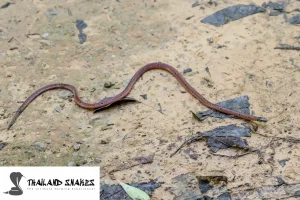
Length: Average max length is 35 cm
Range: These small coral snakes are found all over Thailand and some other countries in Asia. I have seen a couple dozen of these snakes in southern Thailand, usually found by people in their potted plants outside.
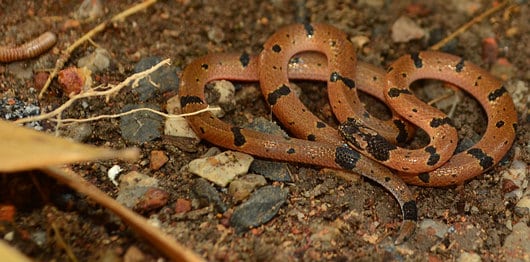
Habitat: These snakes enjoy the leaf litter, loose dirt, and cool areas under rotting trees and other foliage. Occasionally they are seen dead on the road during or after rain when they probably come up above ground to avoid water. They are very rarely found during the daytime, and one scientist said they are usually only seen during September and October. But, I’ve seen them year-round.
Active Time? Nocturnal – active almost exclusively at night, or underground during the daytime.
Food: Very small snakes like the Brahminy blind snake, worm snakes, worms, and probably termite, ant, and other insect eggs.
Defensive Behavior: They curl up their bright red (pink or orange), white and black spotted tail as a defense mechanism. These snakes have little else for defense, as they don’t usually attempt to bite. The mouth on the Calliophis maculiceps is very small, yet they are fully capable of biting and envenomating humans.
Venom Toxicity: This is a coral snake, so, the potential for life-threatening envenomation does potentially exist. Their venom is neurotoxic. There are places on the human body where this snake could get a good bite in, given the chance. Between the fingers and toes is an ideal piece of skin to bite. Just be very careful with these, and all coral snakes. Just because a snake has not been known to cause significant envenomation in the past, doesn’t mean it won’t happen. If you keep this snake as a pet – be very careful not to get too comfortable holding it – it is potentially a deadly snake.
Offspring: One scientist noted a clutch of just 2 eggs.
Notes: These are remarkably beautiful snakes, and yet so small that they could be mistaken for a worm of some sort if. Body patterns can differ slightly. Some, like this juvenile exhibit black stripes and spots. Some have just spots. Some are almost uniformly brown with very few or light spots. The body of this coral snake is round, without a pronounced vertebral ridge. The belly is bright orange, and the tip of the tail has white and black. When the tail is raised, it is quite stunning. These snakes are common and are kept as pets across the world.

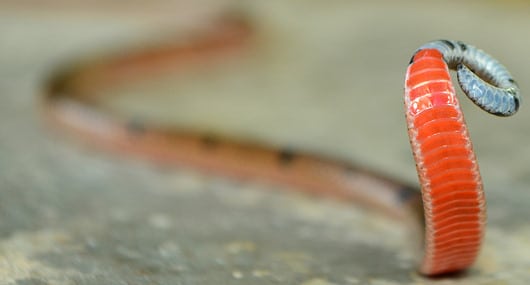
All Photos – ©2011 Vern Lovic
Classification:
Kingdom: Animalia
Phylum: Chordata
Subphylum: Vertebrata
Class: Reptilia
Order: Squamata
Suborder: Serpentes
Family: Elapidae
Subfamily: Elapinae
Genus: Calliophis
Species: C. maculiceps
“Calliophis maculiceps“
(Discovered by Gunther in the year 1858)
Small-spotted Coral Snake Video:

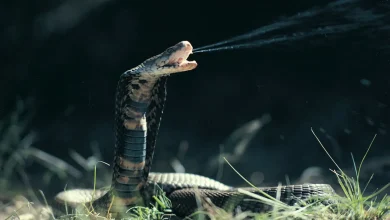
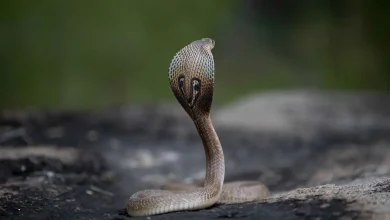
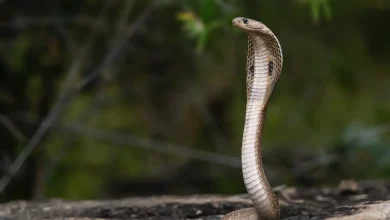
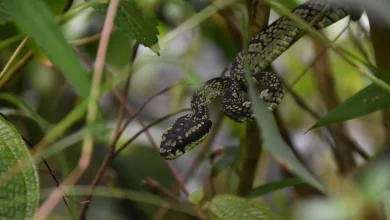
we had a small coral spotted coral snake in garden near house in Phuket yesterday. Suspect fully grown as about 18″ long. I see its potentially dangerous but has small mouth. We also have two beagles that love to sniff any and everything – would this snake pose a problem for the dog if bitten? I suppose it could get a bite in the nose / mouth area?
Hi Peter, Yes, the coral snake is fully capable of killing anything – a dog, human, any pet… Their mouths are VERY small, but there is always the chance that a coral snake can get a fang into a dog somehow. Did you say 18 inches long? You sure it’s a coral snake? That would be full-grown all right. Cheers man…
Thanks for helping me identify.
I was sitting watching TV when I heard a banging sound coming from the garden. I went outside to see the pool cleaner attempting to bash something with the 20 foot long pool pole. “Snake!”, she cries. I can’t see anything, so I walk over to have a look. There is something that looks more like an earthworm. I pick it up, it’s still alive but she’s given it a couple of hefty clumps with the pole and it’s on its last breath. “That’s not going to hurt you”, I tell her.
My daughter is fascinated by snakes so we take it inside and get the snake book.
There wasn’t a great picture in the book, but your website confirmed that this was a ‘deadly’ Coral snake.
I’ll put that as a lucky escape and be more careful in the future!
Yikes… well, the good news is, they are about the most timid deadly snakes you’ll ever meet. They very rarely bite because nobody handles them and they’re not fast to respond to a hand or foot nearby, they just try to get away. Ok, thanks for the story – always love a good story. Cheers!
While in Cambodia, I came across a small (less than two feet) black snake with three blue lines running the length of its back and colored stripes on its belly scales. It was at a picnic grounds outside of Phnom Penh, Was it some type of Coral Snake?
Good question. Sorry, I’m not sure. The bronzebacks have some blue – and some stripes. On the venter though? Corals in Thailand (asia) are not generally that long.
Had a small,slender possibly 7inch pencil or thinner snake with a blueish colour and other lighter colours on it fall from the top of a sliding door or from between the ceiling slats in my bungalow in Koh samui. A lot of bushes and wooded areas near by. It wriggled vigorously to get away but went motionless when cloth Matt thrown on it then swept out door. Anyone got any ideas on species
Hmm. Golden tree snake. Maybe a bronzeback snake. Possibly a pit viper and dangerous. Impossible to say.
Found one of these dead in the garden today in Kaeng Hang Maeo, Chanthaburi with no visible signs of injury.
Was wondering why a coral snake would be in a garden about 50km from the ocean.
Thankyou
Hi Paul,
I think maybe you’re confusing coral snake with ocean krait, or something. Coral snakes are terrestial and sub-terranean. They don’t need the ocean for anything. He maybe died from drying out? Air and ground are very dry during these months and if someone dug him up, maybe it was too dry.
Cheers,
Vern
I have just found one of these little buggers at my aquaponics farm at Bang Rak, Koh Samui. The circumstances and the snake were exactly as you have descibed above. Too cliche to believe, almost.
I had just picked up a stack of three plastic potting trays, carried them over to the hose and then seperatrd them. The snake was in one of the compartments of the second tray.
She looked at me. I looked at her. I decided it wasn’t going to be love a first bite but I didn’t know what she was and she wasn’t aggressive. After a few seconds she slithered off and I washed out the trays. I found two eggs on the ground afterwards.
I looked up what kind she was and your website had the picture of her, exactly (the first, main one).
Nice… what’d you do with the eggs?
Further to my last. I think I forgot to mention there were two eggs there. I showed my staff the picture of the snake and the eggs. She freaked out and crushed both the eggs, unfortunately.
shit…